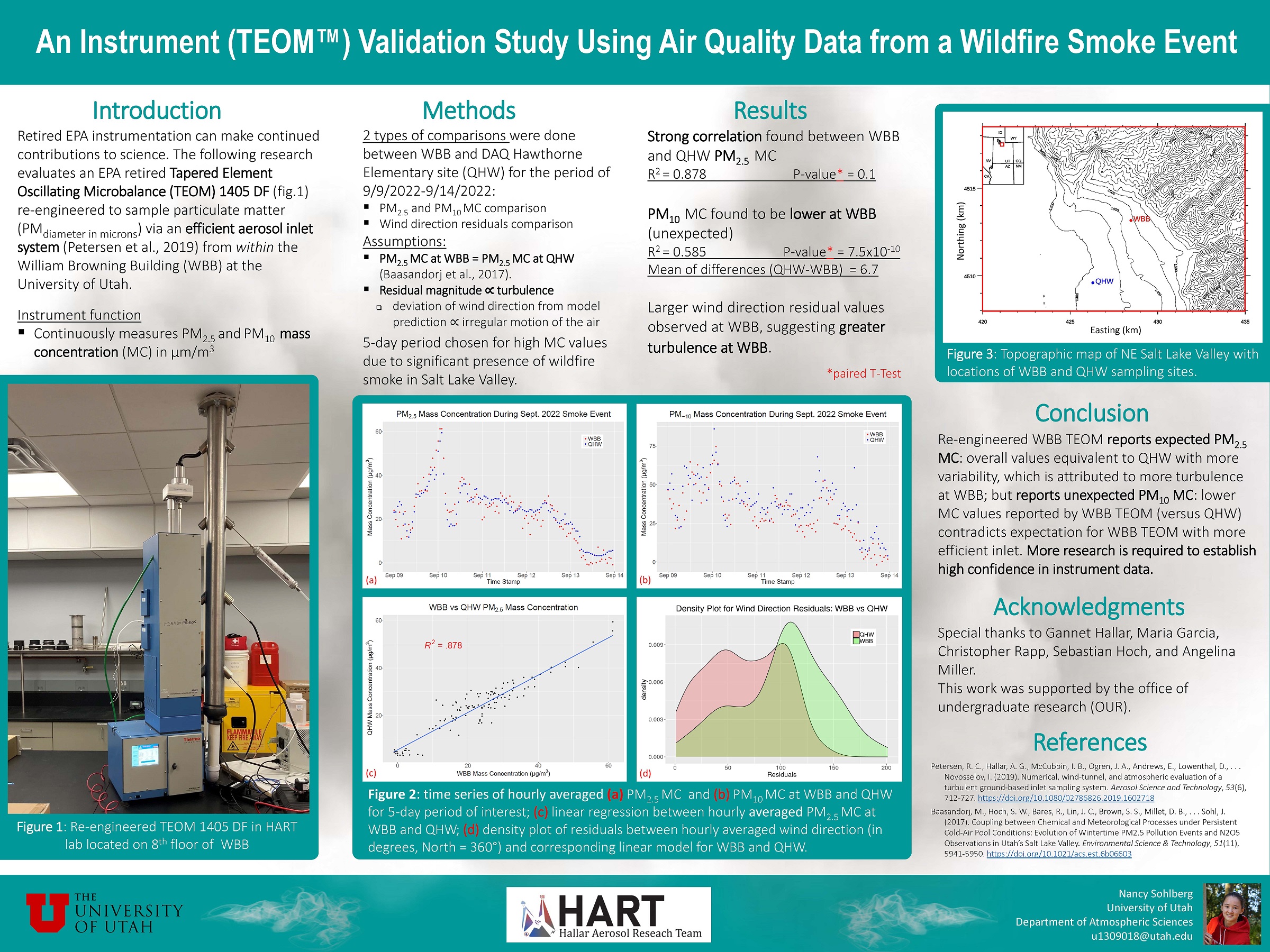Presenter Name: Nancy Sohlberg
Description
This study uses air particulate mass concentration data taken during a 5-day smoke event (9/9/2022-9/14/2022) in Salt Lake City (SLC) to demonstrate the functionality of a re-engineered 1405-DF TEOM™ instrument. The TEOM is designed to be set-up outside with a PM10 inlet head that removes particles above 10 μm in diameter out of a sample air stream, from which PM2.5 is then subsampled. This allows the instrument to take continuous mass concentration measurements of PM2.5 (particles with a diameter of 2.5 μm or less) and PMCoarse (particles with a diameter of ~10 μm or less) in the ambient air. We have re-engineered our TEOM to allow for a larger range of measurements for coarse mode particles by using a different inlet head that has been shown to sample particles up to 13 μm in diameter (Petersen et al., 2019). This inlet is located on the roof of University of Utah's William Browning Building (WBB) and is connected to the TEOM via a large pipe that comes down into our lab where the instrument is located.
Hawthorne Elementary school, located about 3 miles south west of the University of Utah, contains a 1405 series TEOM that follows the set-up laid out in the instrument's standard operating procedure (Ray et al., 2009). This instrument is maintained so that its data can be reported to the EPA, and its PM2.5 mass concentration data is made publicly available. A comparison was done between the PM2.5 mass concentration data from the WBB TEOM and the Hawthorne Elementary TEOM for the period of 9/9/2022-9/14/2022 (fig. 1), which was characterized by a significant presence of smoke in the Salt Lake Valley due to wildfires in the western US. This period was chosen because of its prominent impact on PM2.5 levels, which makes for a more obvious data comparison. Strong correlation was found between the two data sets, suggesting a high degree of performance for the WBB TEOM. This result allows for more confident use of the WBB TEOM's data, and with the instrument's site located up near the Salt Lake Foothills, this data can contribute towards prevalent questions surrounding elevation impact on air quality differences in SLC. This result also opens up opportunity for more TEOM instruments sampling outdoor air to use an indoor instrument location coupled with a broader particle size range inlet. This unique set-up has the potential to extend instrument lifetime, increase instrument accessibility, and enhance instrument ability to sample larger particles like dust (a prominent coarse mode particle with significant environmental impacts). REFERENCES Petersen, R. C., Hallar, A. G., McCubbin, I. B., Ogren, J. A., Andrews, E., Lowenthal, D., ... & Novosselov, I. (2019). Numerical, wind-tunnel, and atmospheric evaluation of a turbulent ground-based inlet sampling system. Aerosol Science and Technology, 53(6), 712-727. Ray, A. E., & Vaughn, D. L. (2009). Standard operating procedure for the continuous measurement of particulate matter. Thermo Scientific TEOM.
Hawthorne Elementary school, located about 3 miles south west of the University of Utah, contains a 1405 series TEOM that follows the set-up laid out in the instrument's standard operating procedure (Ray et al., 2009). This instrument is maintained so that its data can be reported to the EPA, and its PM2.5 mass concentration data is made publicly available. A comparison was done between the PM2.5 mass concentration data from the WBB TEOM and the Hawthorne Elementary TEOM for the period of 9/9/2022-9/14/2022 (fig. 1), which was characterized by a significant presence of smoke in the Salt Lake Valley due to wildfires in the western US. This period was chosen because of its prominent impact on PM2.5 levels, which makes for a more obvious data comparison. Strong correlation was found between the two data sets, suggesting a high degree of performance for the WBB TEOM. This result allows for more confident use of the WBB TEOM's data, and with the instrument's site located up near the Salt Lake Foothills, this data can contribute towards prevalent questions surrounding elevation impact on air quality differences in SLC. This result also opens up opportunity for more TEOM instruments sampling outdoor air to use an indoor instrument location coupled with a broader particle size range inlet. This unique set-up has the potential to extend instrument lifetime, increase instrument accessibility, and enhance instrument ability to sample larger particles like dust (a prominent coarse mode particle with significant environmental impacts). REFERENCES Petersen, R. C., Hallar, A. G., McCubbin, I. B., Ogren, J. A., Andrews, E., Lowenthal, D., ... & Novosselov, I. (2019). Numerical, wind-tunnel, and atmospheric evaluation of a turbulent ground-based inlet sampling system. Aerosol Science and Technology, 53(6), 712-727. Ray, A. E., & Vaughn, D. L. (2009). Standard operating procedure for the continuous measurement of particulate matter. Thermo Scientific TEOM.
University / Institution: University of Utah
Type: Poster
Format: In Person
Presentation #D79
SESSION D (3:30-5:00PM)
Area of Research: Science & Technology
Email: u1309018@utah.edu
Faculty Mentor: A. Gannet Hallar

